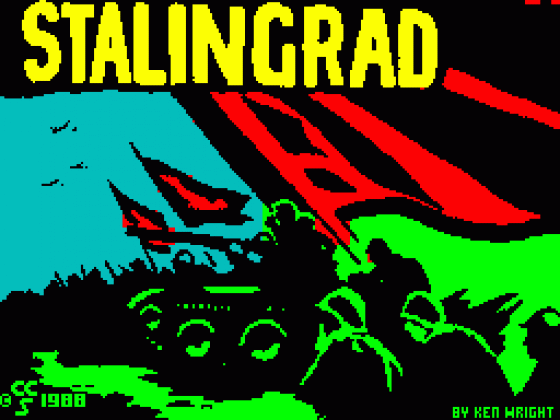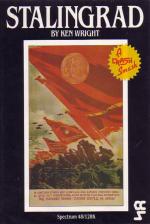
Crash
 1st August 1988
1st August 1988
Categories: Review: Software
Author: Philippa Irving
Publisher: Cases Computer Simulations
Machine: Spectrum 48K
Published in Crash #55
Stalingrad
Stalingrad is the latest game by wargaming's only current prolific writer, Ken Wright. It takes up the often-documented campaign on the Eastern Front in the Spring of 1942, when Field Marshal Von Bock led the German Army Group south, into a drive to capture Stalingrad. The war on the Eastern Front had been draining the resources of both armies and, by this stages It was no longer possible to keep up operations along its extent. Both sides decided to concentrate on the southern sector.
The capture of Stalingrad was intended only to be a stage on the inwards sweep towards the centre of Russia around Moscow. In reality, it proved to be an intractable objective and the whole Russian campaign foundered on it.
The game gives the player command of seven German armies, most consisting of six units. It is set firmly in the mould of the author's previous games (Yankee, Blitzkrieg, Overlord), with an increasing trend to what might be called 'system minimalism'; there is no need to take a degree course in the operation of the game. Statistics are thin on the ground and all the player does to issue orders is move units in blocks of three and choose between a handful of generalised attack options. It's a deliberate attempt to emphasise the gameplay itself, rather than distract with superfluous details and hinder with difficult order systems.

The system is essentially the same as that seen in Ken Wright's previous two campaign games, Blitzkrieg and Overlord. Wargamers who own either will find no surprises in Stalingrad and may be tempted to start playing as soon as the game finishes loading. However, a careful reading of the rules and background is strongly advised as a preliminary. There are a few important additions to the system, and, as usual, it's necessary to bring both knowledge and imagination to get the most atmosphere out of the onscreen abstractions.
The screen map is as attractive as its possible for a computer 'board' map to be. Terrain is neatly and clearly differentiated, and the names of towns are indicated onscreen. There is certainly something to be said for concentrating on making the screen map self-sufficient and attractive.
There are seven different type of terrain, which carry their own movement cost and advantage or disadvantage for attacker or defender. Unfortunately you can't exploit these to the full as it's too difficult to predict where any unit is going to end up after a movement phase, and the decision about whether or not to engage in combat is usually taken out of your hands.
The player, adopting the persona of Field Marshall Von Bock, commands the 1st and 4th Panzer Armies, the 2nd, 6th, 11th and 17th Armies and the Rumanian Army. Apart from the 2nd, the armies are divided into a right and left flank of three units each. The right and left flanks are treated as separate entities for the purposes of orders. The only statistics available for each unit are a rough percentage estimate and an indication of morale.
Orders are issued through a series of simple branching menus. Movement and combat orders are given in a single tum, and executed immediately afterwards. In the orders phase, the player can inspect what limited information is available about his units as well as the percentage strength of whatever enemy units are sufficiently in range to appear on the screen.
Having selected a particular army, the player issues movement Instructions as in Blitzkrieg. Instead of plotting out a straightforward path for each unit, the player must indicate a general line of advance for the centre, right and left flanks of the army. When movement Is processed, the three units dot along the landscapes in an unpredictable approximation of these flanks.
Even after three extensively played games using this system, I still haven't got to grips with it. It seems to carry the notion of reproducing the difficulties of command beyond the borders of frustration.
Combat orders can only be given to the block of three units, in advance of seeing where they will end up. ATTACK means that the units will throw themselves wholeheartedly at any enemy, whether it seems like a good idea or not. Units with a DEFEND order will not attack AND fight back with a bonus added to their effectiveness. But the most common order to give is DISCRETION, which leaves the decision whether or not to engage in combat entirely in the hands of the army commanders. The unsubtle nature of the 'attack' orders leave the player little choice.
Once all orders are entered, movement and combat take place with satisfying speed. Combat is won by flashing units and percentage losses for each side, and is sometimes accompanied by retreat or advance.
There is a carefully worked out supply network which the player must study; cities link across the map in a chain of supply which is easily broken. Once an army is out of supply, it cannot participate in the replacement phase which takes place every tum. This highly stylised phase allows the player to dish out reinforcement points from a general pool to all armies in supply. It's very easy to be inattentive to the invisible supply chain, and to find whole armies suddenly wasting away.
There are three difficulty levels, which step upwards sharply. The manual informs the player how to increase the difficulty indefinitely by means of a POKE. Yes - this game can be broken into by pressing the BREAK key, and it cheerfully advertises the fact. This is a refreshing lack of paranoia on the part of CCS!
The game's main strength is the quality of the computer opponent. On the third level, the only way to win is to outplay the opponent, consistently and constantly making better decisions.
I have the same misgivings about this game that I had about Overlord; I find it so difficult to control the units in a sensible manner that I'm unable to concentrate on the necessary decision-making and strategy. There is something frustrating about having so little control in a game which is beautifully designed and undoubtedly clever. You tell the units to fight if they want to, but only if it's not too much bother... and then you sit back and watch.
Nevertheless, it is possible to get used to the system and there's no doubt that it makes for very streamlined, absorbing gameplay. There are no ungainly pauses or ragged edges. The variety of strategy available is enough to hold interest through many successive games. This is another serious wargamer's wargame which is also accessible to the newcomer, and everyone but the most hardened arcade addict should enjoy playing it.
Other Reviews Of Stalingrad For The Spectrum 48K
Stalingrad (Cases)
A review by Archie (Your Sinclair)
Stalingrad (Cases)
A review by Jon Riglar (Sinclair User)












